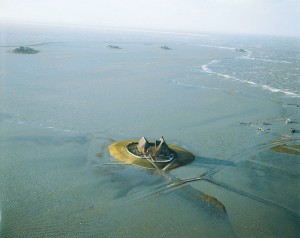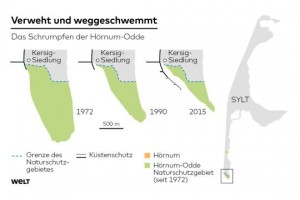The crisis of rising sea levels has never been clearer for the residents of Germany’s North Sea islands. The historic Halligen Islands and the popular holiday destination of Sylt are all at risk.
- The crisis of rising sea levels is often associated with low-lying island nations such as the Maldives Republic
- Recent studies carried out by Eurosian, the European initiative for sustainable coastal erosion management, reveal the problem to be a lot closer to home than first thought
- Two-thirds of Germany’s 3,700km coastline suffering from erosion. The Halligen Islands and Sylt are at particular threat of going under…

Halligen Islands at High Tide – Photo Courtesy of Klett-Interaktiv.de
The crisis of rising sea levels is often associated with far-flung, low-lying island nations such as the Maldives, Kiribati and the Marshall Islands. Yet as a study carried out by Eurosian, the European Initiative of Coastal Management, points out, the problem is a lot closer to home than first thought.
Germany is at particular risk, with two-thirds of its 3,700 km coastline already suffering from shocking levels of erosion. If nothing is done soon, there is a very real dangers that some of the country’s most iconic North Sea islands could succumb to the waves. Private Island News takes a look at some of the most at-risk-islands.
Historic Halligen Islands in Danger of Disappearing
Life on Germany’s historic Halligen Islands has never been easy. Formed by the tides of the North Sea and inhabited since the Middle Ages, the islands have long since been at the mercy of the wild weather of the North Sea.
The hardy residents of the islands have developed clever strategies in order to cope with the omnipresent threat of storm surges throughout the years, building their dwellings and farmhouses atop ten metre-high hills known as “waften.” When flooding occurs, the islanders simply take their cattle and flee to their “waften” and wait for the high tides to subside.
It’s a strategy that has worked for hundreds of years. But with tides rising at an alarming rate (largely a result of global warming), there’s an increasing danger that it won’t be long until these historic islands disappear beneath the waves forever.
Southern Tip of Sylt Set to Break Off?

Diagram Showing the Dramatic Disappearance of Sylt’s Coast Line – Courtesy of Die Welt
It’s a similar story on the popular German holiday island of Sylt, where it’s feared that rapidly increasing levels of coastal erosion could lead the island’s southern tip of the island to break off altogether.
The Hörnummer Odde – a grassy region located towards the south of the island beloved by hikers and nature lovers, has witnessed a rapid onset of erosion, losing – on average – 4 meters of coast line per year. Shocking aerial photos show the full scale of the damage – the Odde, which once comprised a surface area of 151 acres, has since shrunk down to just 30 acres.
And that’s only the beginning of it– in an interview with local newspaper Hamburger Abendblatt, the Mayor of Sylt warned that if something is not done soon, the tip of the island could yet break-off altogether. He believes that without greater commitment to long-term, responsible coastal management, the island is in grave danger of disappearing – piece for piece.
Read more:
- Will Small Islands Vanish Beneath the Waves?
http://www.privateislandnews.com/will-small-islands-vanish-beneath-the-waves/ - Kiribati Prepares for Climate Change Evacuation, Purchasing Land in Fiji
http://www.privateislandnews.com/2014-sep-15-pacific-kiribati-prepares-for-climate-change-evacuation-purchasing-land-in-fiji/ - Climate Change Documentary on Sinking Micronesian Island
http://www.privateislandnews.com/south-pacific-climate-change-documentary-features-sinking-micronesian-island/


